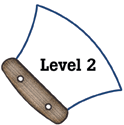|
National Science Education Standards
Populations of organisms can be categorized by the function they serve
in an ecosystem. Plants and some microorganisms are producers–they
make their own food. All animals, including humans, are consumers, which
obtain food by eating other organisms. Decomposers, primarily bacteria
and fungi, are consumers that use waste materials and dead organisms for
food. Food webs identify the relationships among producers, consumers,
and decomposers in an ecosystem. (Page 157)
For ecosystems, the major source of energy is sunlight. Energy entering
ecosystems as sunlight is transferred by producers into chemical energy
through photosynthesis. That energy then passes from organism to organism
in food webs. (Page 158)
|
|
Benchmarks
Almost all kinds of animals’ food can be traced back to plants.
(Page 119)
Some source of “energy” is needed for all organisms to stay
alive and grow. (Page 119)
Over the whole Earth, organisms are growing, dying, and decaying, and
new organisms are being produced by the old ones. (Page 119)
|

